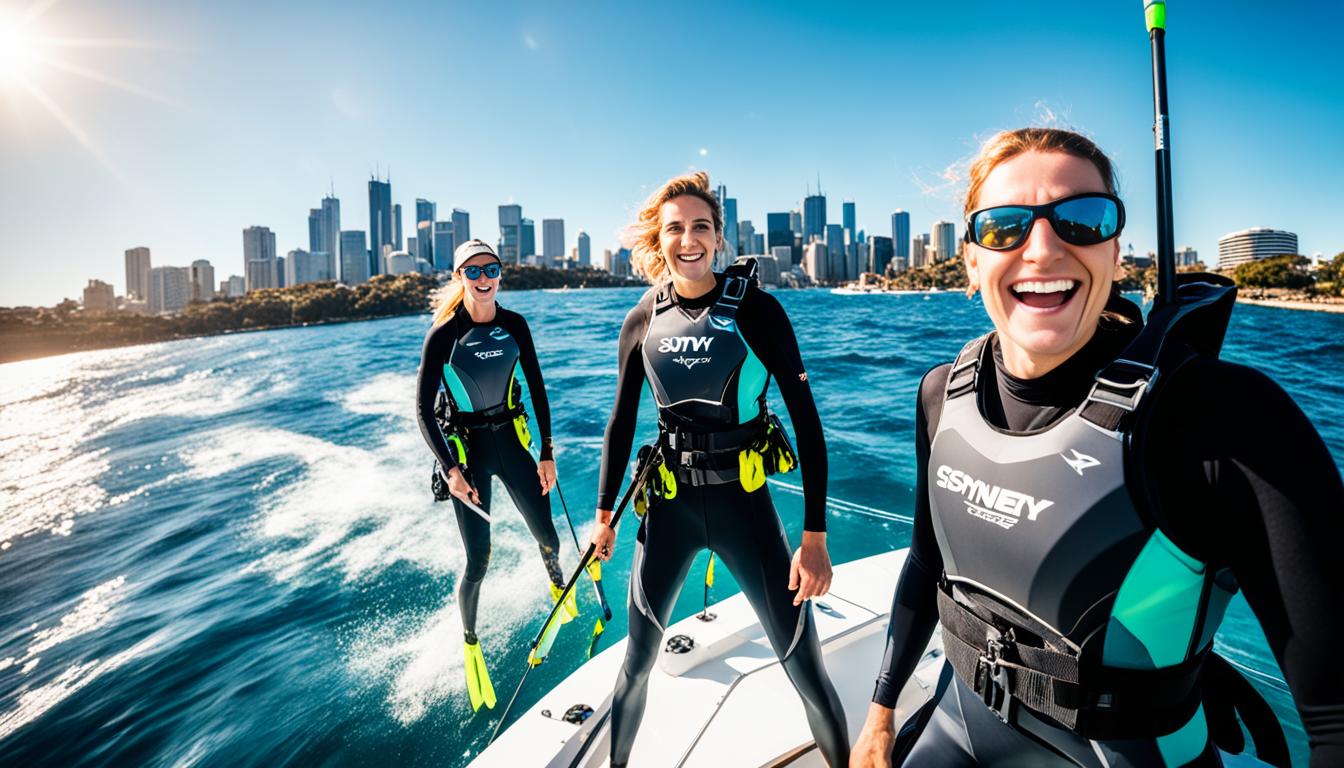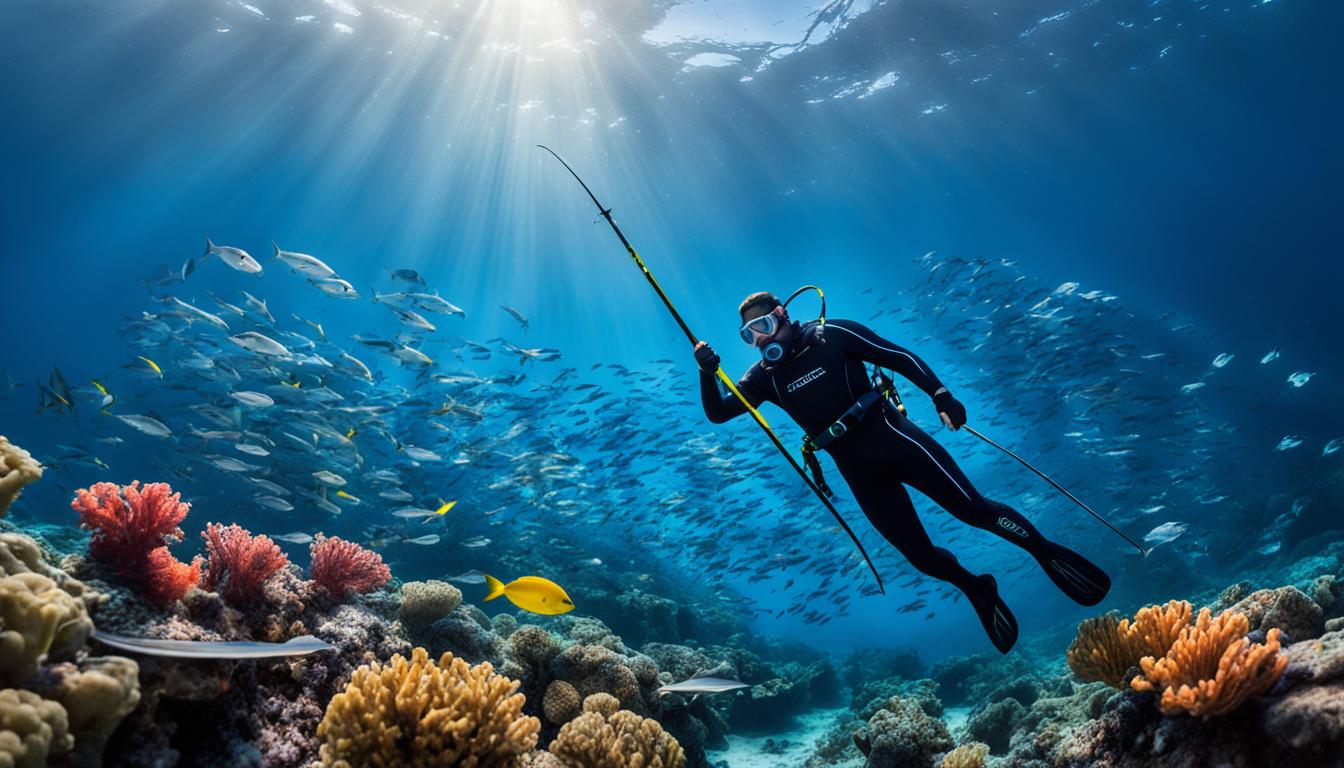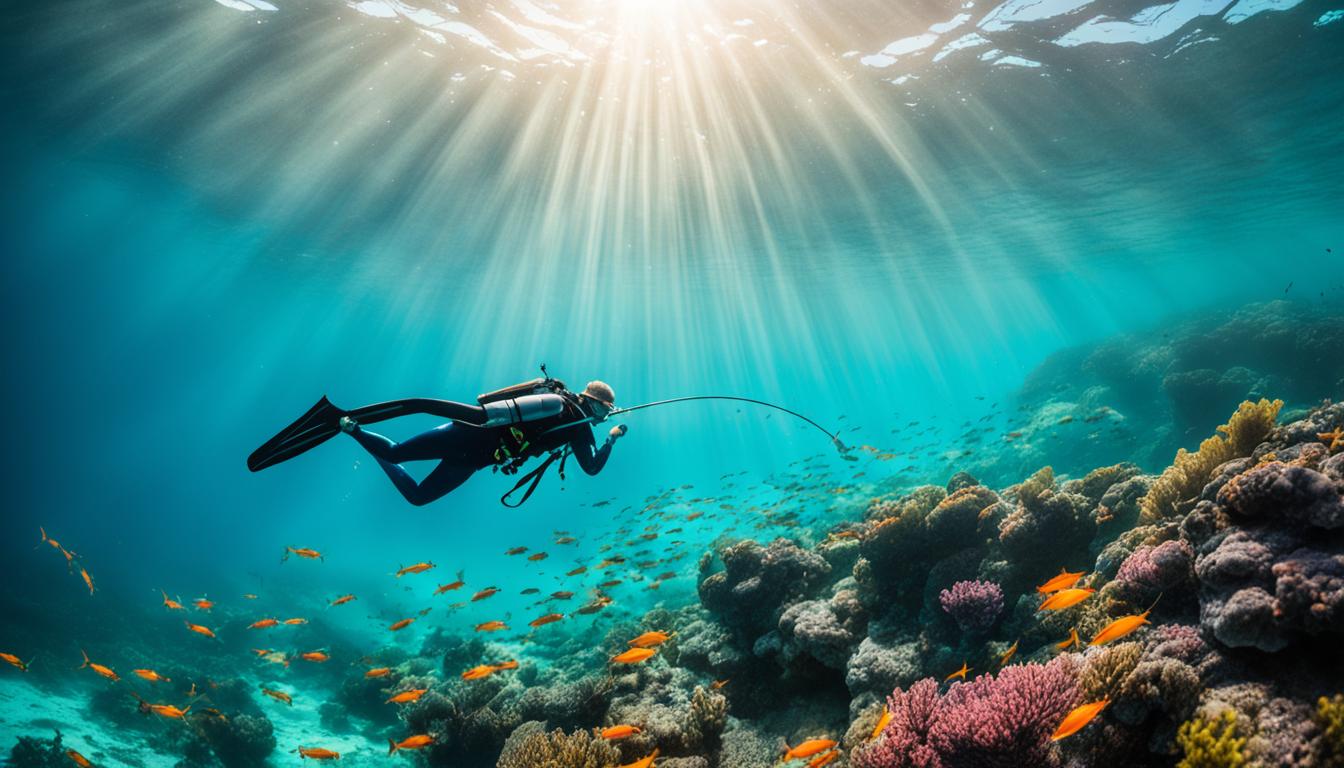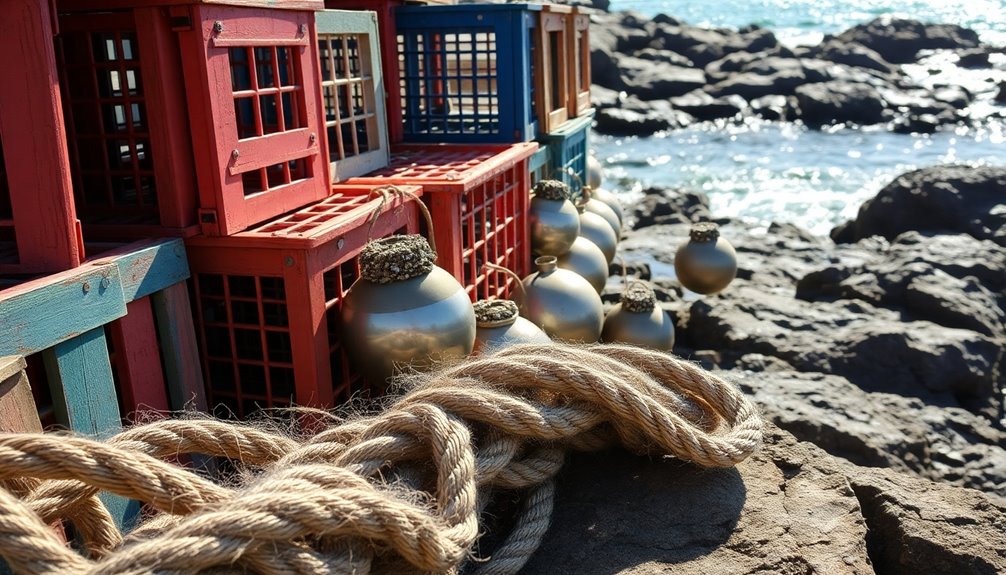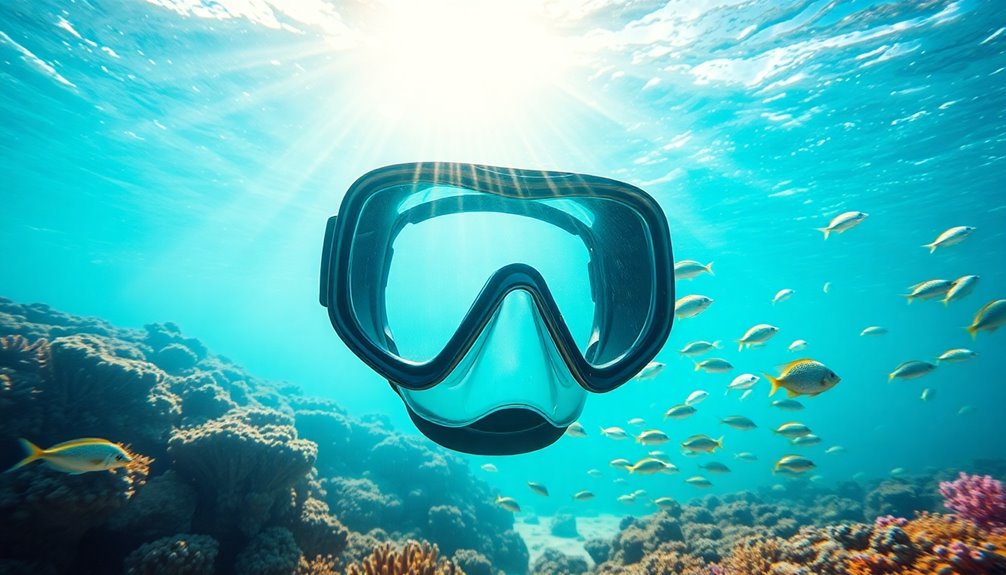Have you ever been captivated by the mysteries beneath the surface of the ocean? Do you dream of gliding through the water, surrounded by marine life, and exploring the hidden depths? If so, it’s time to turn that dream into a reality with the Spearfishing Course Sydney!
Designed specifically for beginners, this underwater hunting course provides the perfect introduction to the exhilarating sport of spearfishing. You don’t need any previous experience in spearfishing or freediving to enroll in this course. Our experienced instructors will guide you through every step, ensuring a safe and rewarding learning experience.
Enrolling in the Spearfishing Course Sydney offers a wealth of benefits. Not only will you learn essential techniques, equipment handling, and safety protocols, but you will also have the opportunity to explore the vibrant underwater world of Sydney’s coastline.
Key Takeaways:
- Designed for beginners with no previous spearfishing or freediving experience required
- Maximum course ratio of 4:1 for personalized attention and instruction
- Swimming requirements include being able to swim at least 200m nonstop without fins and at least 300m nonstop with mask, snorkel, and fins
- Certification options available upon course completion
- Sydney has several reputable spearfishing shops, such as Adreno Spearfishing in Alexandria, Spearfishing Superstore in Taren Point, and Dive Spear and Sport in North Manly
Discover the Spearfishing Course
If you’ve ever dreamed of exploring the underwater world and experiencing the thrill of hunting underwater, our spearfishing course in Sydney is the perfect opportunity for you. Designed specifically for beginners, this comprehensive course will equip you with the essential skills, knowledge, and safety procedures needed to enjoy spearfishing to the fullest.
Our beginner spearfishing course is a weekend-long program that covers both theory and practical components. Led by experienced instructors such as Isaac (Shrek), Tom, Brandon, Tim, and Trevor, you’ll learn everything from the basics of spearfishing techniques to proper breathing and dive safety protocols.
The course begins with a classroom session, where you’ll gain a solid understanding of equipment, fish behavior, and the proper way to handle catches. You’ll also learn about spearfishing ethics and conservation practices to ensure that you engage in the sport responsibly.
Once you have a solid foundation of knowledge, it’s time to get hands-on. In the water, our instructors will guide you through breathing exercises, allowing you to increase your breath-holding capacity and become calm and confident underwater. You’ll practice various diving techniques and learn how to properly aim and shoot your speargun.
By the end of the course, you’ll have the opportunity to put your skills to the test. Participants have achieved depths of up to 10 meters after completing the course, earning their dive certification. Throughout the course, you’ll also have the opportunity to shoot fish, with an average of three successful catches reported by participants.
At the conclusion of the course, you’ll also learn how to properly treat the fish you’ve caught, ensuring that you respect and honor the creatures you encounter in the water.
Don’t just take our word for it. Our Google rating is a stellar 5.0 out of 5, based on 24 reviews. Participants have praised the course for its thoroughness, expert instruction, and the valuable skills they acquired.
“Dog and Gun Coffee is bloody good coffee.” – A satisfied customer
As an added bonus, our partnership with Dog and Gun Coffee provides you with the opportunity to enjoy exceptional coffee during your training sessions, ensuring that you stay energized and focused throughout.
Simon Trippe, an Australian Spearfishing Academy Instructor, emphasizes the importance of quality gear when starting spearfishing. He recommends building relationships with experienced spearfishing retailers to ensure you have the right equipment from the beginning. This approach can save you money in the long run, as you won’t need to constantly upgrade inadequate gear.
Joining a club, seeking advice from experienced spearos, and taking accredited courses are other recommendations from Trippe. These steps will help you learn proper techniques, breathing methods, and club culture, all of which are essential for a safe and enjoyable spearfishing experience.
Discover a New World Underwater
Embark on your spearfishing journey today and unlock the thrill of exploring the underwater world like never before. Our spearfishing course in Sydney will provide you with the skills, knowledge, and confidence to dive deep and hunt underwater, all while embracing the importance of safety, conservation, and respect for marine life.
Enroll in our beginner spearfishing course now and become part of an exciting community of spearos who share your passion for the sport.
Course Fees and Schedule
Enrolling in a spearfishing course in Sydney offers you the opportunity to learn from experienced instructors and gain the necessary skills for a thrilling underwater adventure. Let’s take a closer look at the course fees, schedule, and what to expect during your training.
Spearfishing Course Fees
There are two options available for spearfishing training in Sydney:
| Course | Duration | Price |
|---|---|---|
| One-Day Course | 1 day | $305 |
| Two-Day Course | 2 days | $575 |
Both courses offer comprehensive training, covering equipment handling, fish identification, hunting techniques, safety protocols, fish behavior, and ethics. Additionally, you’ll receive freediving instruction to improve your underwater skills. As an added bonus, participants of the two-day course receive 3 free bonuses and a $50 voucher for any Adreno store upon completion.
Schedule and Locations
The spearfishing courses are conducted throughout the year in various locations, including Sydney, Perth, Melbourne, Central Coast, Gold Coast, and Brisbane. This ensures flexibility for participants to choose a course and location that suits their preferences.
For the two-day course, the training schedule is as follows:
- Thursday: Theory and pool sessions from 5:00pm – 9:00pm
- Saturday: Ocean sessions from 9:00am – 4:30pm
- Sunday: Ocean sessions from 9:00am – 4:00pm
It’s essential to secure your spot by making a $150 deposit, with the balance due two weeks before the course starts. The instructor-to-student ratio is maintained at 1:3, ensuring personalized attention and guidance throughout the training.
AIDA 2 Course
If you’re eager to take your spearfishing skills to the next level, consider the AIDA 2 certification program. This three-day course focuses on expanding your knowledge and abilities in freediving, safety, rescue techniques, and equalization. The AIDA 2 course is available in Sydney for $550, in Byron for $620, and in Perth and Melbourne for $650.
To enroll in the AIDA 2 course, you’ll need to meet the following prerequisites:
- Ability to swim 300m non-stop with mask, fins, and snorkel
- Minimum age requirement of 18 years old or 16 with parent/guardian approval
With a ratio of 1:1.5 between theory and practical sessions, the AIDA 2 course provides a well-rounded learning experience to enhance your spearfishing journey.
Whether you choose the one-day or two-day course or decide to pursue the AIDA 2 certification, spearfishing training in Sydney offers you the opportunity to learn from the best and embark on thrilling underwater adventures.
Specialized Equipment for Spearfishing
When it comes to spearfishing, having the right equipment is essential for a successful and enjoyable underwater hunting experience. Dive Gear Australia offers a wide range of specialized gear specifically designed for spearfishing enthusiasts. From spearguns and wetsuits to snorkels and fins, you’ll find everything you need to dive into the thrilling world of spearfishing.
Spearguns
One of the most important tools for spearfishing is a reliable speargun. Dive Gear Australia offers a variety of spearguns, including the Cressi Apache Speargun, available in sizes ranging from 35cm to 75cm, with prices starting at $139. For those looking for more power, the Cressi Mohawk Twin 16mm Speargun is a great choice. It comes in sizes from 80cm to 130cm, with a reduced price from RRP $499 to $459, allowing you to save $40 (8%).
Wetsuits
A high-quality wetsuit is essential for staying comfortable and protected while spearfishing. Dive Gear Australia offers the Ocean Hunter Chameleon Core-3 Spearfishing Wetsuit, a 3mm wetsuit priced at $151, with a saving of $8 (5%). This camouflage wetsuit provides excellent insulation and flexibility, allowing you to move freely underwater without compromising your stealth.
Fins
Having the right fins is crucial for efficient movement in the water. Dive Gear Australia offers a selection of freediving fins that are perfect for spearfishing. The Cressi Reaction Pro Full Foot Fins are offered at a price of $99, allowing you to save $10 (9%). If you prefer a modular design, the Cressi Gara Modular Full Foot Fins are priced at $179, with a saving of $20 (10%). These high-performance fins provide excellent propulsion, allowing you to cover more ground and chase after your target fish.
Snorkels
A good snorkel is important for efficient and comfortable breathing while spearfishing. Dive Gear Australia offers the Apollo SVS Pelagio ‘J’ Spearfishing Snorkel, priced at $36, allowing you to save $4 (10%). This snorkel features a streamlined design and a durable construction, ensuring optimal airflow and minimal water entry.
Additional Accessories
In addition to the essentials, Dive Gear Australia also offers a range of accessories to enhance your spearfishing experience. From dive socks and float lines to dive gloves and flashers, you’ll find everything you need to equip yourself for a successful hunt.
With Dive Gear Australia’s carefully curated spearfishing packages, you can get all the specialized equipment you need in one convenient set. Whether you’re a beginner or an experienced spearfisher, these packages cater to different skill levels and preferences. Each package is tailored to the specific demands of Australian waters, whether you’re reef hunting, spearfishing in bluewater, or exploring the shores.

With Dive Gear Australia’s specialized equipment, you can dive deeper, hunt smarter, and make the most of your spearfishing adventures in the beautiful waters of Australia.
Explore Other Underwater Activities
While spearfishing is an exciting underwater sport, it’s not the only way to discover the wonders of the ocean. If you’re looking to broaden your underwater exploration horizons, there are plenty of other activities to try, such as snorkeling.
Snorkeling offers a more accessible and leisurely approach to observing marine life. With just a mask, snorkel, and fins, you can explore the vibrant underwater world without the need for extensive training or expensive equipment.
At The Underwater Academy, we understand the importance of providing enthusiasts with high-quality snorkeling gear that enhances their experience. Our range includes comfortable masks that provide a clear view of the underwater landscape, innovative fins that enhance propulsion and maneuverability, and even full-face snorkel masks for those who prefer a more immersive experience.

Whether you’re a beginner or an experienced snorkeler, our diverse range of snorkeling gear caters to all skill levels and preferences. We believe that everyone should have the opportunity to connect with nature and experience the wonders that lie beneath the surface.
So, if you’re curious about snorkeling and want to add it to your underwater exploration repertoire, visit The Underwater Academy and let us provide you with the gear you need for an unforgettable adventure.
Importance of Safety in Spearfishing
Spearfishing is an exhilarating underwater activity that combines skill, precision, and a deep connection with the ocean. However, it is crucial to prioritize safety to ensure a safe and enjoyable experience. In the spearfishing course in Sydney, safety is given utmost importance, with certified instructors guiding students through essential safety procedures.
Spearfishing training in Sydney not only focuses on honing your physical endurance, mental preparation, hunting skills, and overall diving technique, but also emphasizes the importance of safety measures. By equipping yourself with the necessary knowledge and skills, you can minimize risks and make informed decisions while underwater hunting.
One of the key aspects of safety training in spearfishing is delay training. This form of training involves drills that enhance your ability to stay calm and composed while underwater. Examples of delay training drills include 30-second static, 50m dynamic; 25m dynamic, 30-second static, 25m dynamic; and 50m dynamic, 30-second static. By incorporating different scenarios like descent, freefall, waiting, scouting, and ambush into delay training, you can further improve your spearfishing skills and react effectively in various situations.
Pool training is another essential component of the spearfishing course. The advantage of practicing in a controlled environment like a pool is that you can push yourself closer to the limit safely compared to training in the unpredictable sea. Regular practice of rescues in training is crucial for efficiency and safety in spearfishing, as it prepares you to handle emergency situations effectively.
Furthermore, learning how to position and control dead weight while swimming is emphasized in the training. This skill is invaluable in scenarios like retrieving large catches or assisting friends in distress. The spearfishing course in Sydney ensures that you are equipped with the necessary techniques and strategies to handle such situations with ease.
To ensure continuous skill development, it is recommended to have at least one pool session per week. This consistent practice can lead to gradual steady improvement. However, training more frequently can result in more significant progress in your spearfishing abilities.
While the spearfishing course provides valuable training, it is important to supplement it with other safety practices. Diving with a partner is strongly recommended for added safety. Additionally, considering taking spearfishing or freediving courses and joining a local club can further enhance your knowledge and foster a community where safe diving practices are prioritized.
Safety Guidelines for Spearfishing in Sydney:
- Always obtain a current New South Wales fishing license to spearfish in the area.
- Keep a safe distance of 50 meters from other swimmers, snorkelers, scuba divers, and fishermen to avoid accidents and ensure everyone’s safety.
- Become familiar with the risks involved in spearfishing, including shallow water blackout, boat traffic, dangerous marine creatures, and currents. Taking an accredited spearfishing and freediving class is highly recommended for safety.
- Respect protected species in New South Wales, such as the blue groper, by avoiding their capture.
- Carry a high-vis float and a diver down flag to increase your visibility and alert others about your presence in the water.
- It is legal to use a torch while spearfishing in New South Wales. However, use it responsibly and ensure it doesn’t disturb other divers or marine life.
Spearfishing can be an incredibly rewarding and safe activity when proper precautions are taken. By enrolling in the spearfishing course in Sydney and following the recommended safety guidelines, you can embark on an extraordinary underwater adventure while minimizing risks and ensuring the safety of yourself and others around you.

Course Instructors and Ratios
At the spearfishing course Sydney, you will learn from experienced instructors who are passionate about spearfishing and freediving. The course instructors have extensive knowledge and expertise in these fields, ensuring that you receive top-notch training and guidance throughout your journey.
Apnea Australia prides itself on maintaining small course ratios to provide personalized attention to each student. With a maximum of 4 students per open water dive, you can have confidence in the individualized instruction you will receive. This small group size allows the instructors to focus on your specific needs and ensure that you grasp the techniques and skills required for successful spearfishing.
When it comes to specialized courses such as FRC, Performance training, and specialties, Apnea Australia develops them with utmost quality in mind. These courses are designed to enhance your skills and expand your knowledge in specific areas of spearfishing. Whether you’re interested in deep diving, underwater hunting, or underwater photography, Apnea Australia has tailored courses to meet your needs.
Apnea International, the certification provider for Apnea Australia, guarantees that the education you receive during the spearfishing training Sydney is internationally recognized. This certification opens up opportunities for you to participate in freediving competitions worldwide and further your spearfishing career.
| Instructor | Experience |
|---|---|
| Dennis McHugh | Owner and Manager Director of Frog Dive since 2000 |
| John Warner | Instructor at Frog Dive since 1996 |
| Larissa Alves | PADI OW and Specialty Instructor at Frog Dive since 2016 |
| James Lauder | Casual PADI OW Instructor at Frog Dive |
Frog Dive Scuba Centres, one of Sydney’s oldest dive shops, takes pride in its team of instructors who bring a wealth of experience and knowledge to the training. Dennis McHugh, the owner and manager director of Frog Dive, has been an integral part of the shop since 1987. John Warner, another instructor at Frog Dive, has been with the shop since 1996 and holds instructor ratings in various diving courses.
Larissa Alves and James Lauder are also part of the experienced team at Frog Dive. Larissa joined in 2016 and is a full-time PADI OW and Specialty Instructor, responsible for coordinating diving operations. James became an instructor in 2015 and is currently studying to be a teacher, bringing a fresh and enthusiastic approach to the training.
With these knowledgeable instructors leading the courses, you can be confident in receiving the best education and guidance during your spearfishing workshop in Australia.
Pre-Requisites for the Spearfishing Course
Before enrolling in the spearfishing course in Sydney, there are a few pre-requisites that you need to meet. These requirements ensure that you have the necessary skills and qualifications to fully participate and benefit from the course.
Age Requirement
The minimum age to enroll in the spearfishing course is 18 years old. However, if you are 16 or 17 years old, you can still join the course with parental permission and supervision.
Swimming Ability
To ensure your safety and enjoyment during the course, it is important to have a certain level of swimming ability. You should be able to swim a distance of 300 meters with fins on. This requirement ensures that you are comfortable and confident in the water, as swimming plays a crucial role in spearfishing.
Fishing License
Depending on the relevant state law, you may need to hold a valid fishing license before participating in the spearfishing course. It is important to check with the local authorities to ensure compliance with the regulations.
Certification Exemptions
If you already hold an AIDA 1 free diver certification, you may be exempt from certain pre-requisites, such as the swimming ability requirement. The course instructors will assess your certification and determine if any adjustments need to be made to the pre-requisites.
By meeting these pre-requisites, you can confidently enroll in the spearfishing course and embark on an exciting journey to discover the underwater world. The instructors, with their extensive experience in spearfishing, freediving, and marine science, will guide you through the course, ensuring you gain the necessary skills and knowledge to become a skilled spearfisher.
Join our spearfishing course in Sydney today and unleash your underwater potential.
Getting Spearfishing Level 1 Certified
When you enroll in the underwater hunting course in Sydney, you have the unique opportunity to become Spearfishing Level 1 certified. This certification program is designed to enhance your spearfishing education and skills, ensuring that you have the knowledge and expertise to enjoy this thrilling activity safely and responsibly.
The Spearfishing Level 1 course is taught by experienced instructors who will guide you through the foundations of freediving, enabling you to dive to depths of 12-20 meters on a single breath. With course locations available in Sydney’s Northern Beaches, Eastern Suburbs, and the Central Coast, you can choose the most convenient option for you.
Whether you are a beginner or someone with prior freediving, spearing, surfing, or diving experience, this course is open to all. Group bookings are also available, allowing you to share the freediving experience with your friends or fellow enthusiasts.
Course Structure and Certification
The Spearfishing Level 1 course spans over two days and includes comprehensive training sessions. You will delve into theory lessons, hone your skills in pool sessions, practice in open-water sessions, and even embark on boat dives to apply your newfound knowledge in a real-life setting.
Throughout the course, you will be provided with all the necessary gear, including a mask, snorkel, freediving fins, weight belt, and weights. Wetsuits are also available for rent, ensuring your comfort during training.
Upon completion of the Spearfishing Level 1 course, you will receive a certification that is recognized worldwide. You have the option to choose between completing an SSI or Molchanovs program, both of which carry significant weight in the spearfishing community.
In addition to the certification, you will also gain access to a free Freediving Central training program. This opportunity allows you to continue progressing in your freediving skills, ensuring that you can explore the underwater world with confidence and competence.
Course Fees and Schedule
The Spearfishing Level 1 course fees vary depending on the location. For the Sydney Eastern Suburbs, the course is priced at $520, while the Central Coast course, which includes a boat dive, is priced at $600.
Various course dates are available for both Sydney Eastern Suburbs and Central Coast locations, allowing you to find a schedule that fits your availability. Whether you prefer weekend sessions or midweek courses, there are options to accommodate your needs.
Prerequisites and Booking Information
In order to join the Spearfishing Level 1 course, you must meet certain prerequisites. These include being at least 12 years old, completing medical and liability forms, and having the ability to swim 100m unassisted.
Group bookings require a minimum of 7 participants, and there are discounts available for groups of 8 or more. If you are interested in booking a midweek course, there is a minimum booking requirement to consider.
It’s important to note that course payments include non-refundable deposits, with final payments due one week before the course starts. Should you need to reschedule a course, a minimum notice of 7 days is required, and a re-booking fee of $150 will apply within the final week before the course start date.
By enrolling in the Spearfishing Level 1 course, you are not only embarking on an unforgettable adventure but also equipping yourself with the essential skills and certification to enjoy spearfishing to its fullest. Don’t miss out on this opportunity to plunge into the underwater world and become a certified spearfisher!

Next Steps and Enrollment Information
Are you ready to embark on an exciting adventure in spearfishing? Enrolling in a spearfishing course in Sydney is the perfect way to learn the necessary skills and techniques to dive safely and effectively. Follow these steps to take the next leap towards becoming a certified spearfisher.
Step 1: Choose Your Certification Body
Before enrolling in a spearfishing course, it’s important to select the right certification body for your training. In Sydney, you have multiple options, including two certification bodies in New South Wales, one in Queensland, one in Western Australia, and one in Victoria. Each certification body has its unique approach and curriculum, so do your research and find the one that aligns with your goals and preferences.
Step 2: Contact the Certification Body
Once you’ve chosen a certification body, reach out to them to inquire about the upcoming courses and enrollment process. You can contact them through email or phone, and they will provide you with all the necessary information.
| Region | Phone | |
|---|---|---|
| New South Wales | [email protected] | +61 (02) 9583 9662 |
| Queensland | [email protected] | +61 (07) 3890 0342 |
| Western Australia | [email protected] | +61 (08) 9535-2047 |
| Victoria | [email protected] | 0422 631 110 |
Step 3: Complete the Enrollment Process
Once you have gathered all the necessary information from the certification body, you can proceed to complete the enrollment process. This may involve filling out enrollment forms, providing required documentation, and making the necessary payment for the course.
Keep in mind that some courses may have specific prerequisites, such as a minimum age requirement of 10 years old or basic water skills demonstration. It’s essential to meet these requirements to ensure a smooth enrollment process.
Step 4: Prepare for Your Course
Prior to starting your spearfishing course, it’s a good idea to prepare yourself physically and mentally. Make sure you have the suitable personal scuba equipment, including a mask, snorkel, and fins. During the course, additional gear like a regulator, BCD, and dive computer will be provided to you.
If you have any specific questions or concerns about the course or the equipment needed, don’t hesitate to reach out to the certification body for guidance.

Step 5: Begin Your Spearfishing Journey
With your enrollment complete and your gear ready, it’s time to begin your spearfishing journey. Attend the scheduled classes, participate actively, and learn from experienced instructors who will guide you through the ins and outs of spearfishing.
Remember, spearfishing is not just about the thrill of the hunt—it’s also about sustainability and responsible fishing practices. Embrace the lessons taught during the course and always prioritize the well-being of the underwater ecosystem.
So, what are you waiting for? Enroll in a spearfishing course today and dive into a world of excitement and adventure!
Benefits of Spearfishing as a Hobby
Spearfishing is more than just a thrilling underwater sport – it offers numerous benefits as a hobby. Engaging in spearfishing not only allows you to connect with nature but also provides opportunities for physical fitness, personal growth, and a sense of serenity. By enrolling in a spearfishing course in Sydney or attending a spearfishing workshop in Australia, you can unlock these benefits and dive deeper into this captivating activity.
1. Physical Fitness
Spearfishing requires a combination of cardiovascular endurance, strength, and agility. By swimming against currents, honing your finning technique, and carrying specialized equipment, you can improve your overall fitness level. It’s a full-body workout that engages multiple muscle groups, enhancing your strength and stamina.
2. Self-Discipline and Mental Resilience
Mastering the art of spearfishing requires discipline, focus, and mental fortitude. Through regular practice, you’ll develop the ability to control your breath and body, improving your breath-hold capabilities. This self-discipline extends beyond the water, positively impacting other areas of your life as well.
3. Connection with Nature
Spearfishing allows you to immerse yourself in the underwater world, forging a deep connection with the marine ecosystem. Unlike scuba diving, which can disrupt marine life with bulky gear and bubbles, spearfishing enables you to approach marine creatures quietly and observe their natural behavior. It’s a unique way to experience the beauty and tranquility of the underwater world.
4. Stress Relief and Mindfulness
The meditative nature of spearfishing requires careful control of your breath and focus on the present moment. This mindfulness helps clear the mind of distractions and promotes a state of relaxation, reducing stress and anxiety. The calming effect of being underwater and experiencing the rhythm of nature provides a much-needed escape from the pressures of everyday life.
5. Social Interactions
Spearfishing communities exist nationwide, offering a platform for social interactions and support among like-minded enthusiasts. Joining a spearfishing club and participating in organized activities can create lasting friendships, provide opportunities for knowledge exchange, and enhance the overall experience of spearfishing.
6. Affordable Adventure
Compared to scuba diving, spearfishing requires minimal gear, making it a cost-effective activity. With just a mask, snorkel, fins, and a speargun, you can explore the underwater world and embark on thrilling adventures without breaking the bank. It’s a hobby that offers endless possibilities without the need for extensive equipment.
Embarking on a spearfishing journey can be an enriching experience that combines adventure, physical fitness, mindfulness, and a deep connection with nature. By enrolling in a spearfishing course in Sydney or attending a spearfishing workshop in Australia, you can acquire the necessary skills, knowledge, and confidence to fully embrace this exciting underwater pursuit.

Conclusion
As you’ve explored in this article, spearfishing is an exciting underwater activity that offers a unique blend of adventure and conservation. If you’re looking to start your spearfishing journey, enrolling in a spearfishing course in Sydney is the perfect way to get started. The course provides comprehensive training and guidance on the techniques, safety precautions, and equipment necessary for successful spearfishing.
Through the spearfishing course in Sydney, you’ll learn how to navigate local marine protection zones, understand prevailing conditions, and select suitable spearfishing locations. Additionally, the course instructors, who are experienced spearfishers themselves, will ensure that you gain the necessary skills and knowledge to enjoy this activity responsibly.
By pursuing spearfishing, not only will you have the opportunity to explore the underwater world and connect with like-minded enthusiasts through platforms like Facebook groups and spearfishing forums, but you’ll also contribute to marine conservation efforts. Spearfishing is recognized as a sustainable fishing method due to its low capture rate, selectivity, and adherence to local regulations. Spearfishers play an active role in maintaining ecosystem balance by targeting invasive species, participating in ecological research, and spreading awareness about conservation practices.
So, don’t miss out on this incredible adventure! Enroll in a spearfishing course in Sydney today and embark on a journey that combines your passion for underwater hunting with a commitment to marine stewardship. Start exploring the depths, honing your skills, and experiencing the thrill of spearfishing while contributing to the protection and conservation of our oceans. Whether you’re a beginner or an experienced diver, this course offers valuable knowledge and hands-on practice to enhance your spearfishing abilities. If you’re looking for more aquatic adventures beyond Sydney, consider exploring the vibrant underwater world of spearfishing in Brisbane, where unique marine life and diverse ecosystems await. Don’t wait any longer—dive in and make spearfishing a lifelong passion while positively impacting our oceans!

